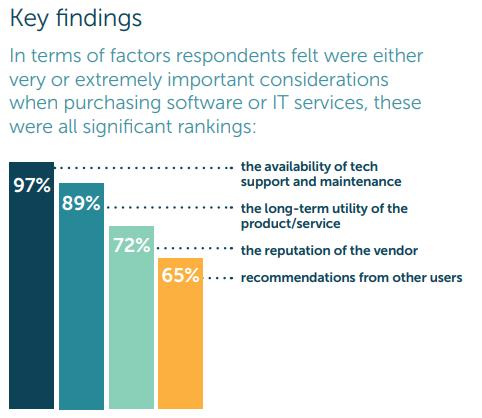New innovations enhance many aspects of our lives, and this includes improving citizen engagement in local government. Innovative technology has become a crucial enabler for delivering more efficient and user-friendly services in all government departments, but especially in local government. More traditional methods of governance are disappearing, with e-governance solutions taking their place.
Continue readingTransforming Local Councils with Digital Innovation When Budgets are Tight
In a world that is becoming more and more focused on digital solutions, there has been a push for transforming Australian councils with digital innovation. Unfortunately, government departments, particularly local Government (LGs), are often way off the pace compared to the private sector when it comes to adopting and implementing modern technologies. One of the main reasons for this is budget constraints and staffing.
Members of the community expect to be able to communicate with their council online, rather than having to visit the council customer service centre whenever they have a query, or an issue with a service. Therefore councils need to adopt modern technology that meet community expectations, and do so within a constrained budget and with their existing staff.
This article discusses the challenges faced by Local Governments in delivering enhanced services to their communities, and how many councils have been able to implement outstanding digital customer service, and within budget.
Bridging the technology gap
Communication and service delivery by councils is greatly enhanced with the adoption of the latest digital technologies available. However, lack of funding and skilled staff has impeded the uptake of new technology, creating a technological gap. It’s an even greater struggle for many regional councils, with extremely limited budgets.
According to a survey conducted by KPMG, only 3% of Australian LGs progressed to the actual digital transformation stage. The survey concluded that along with a lack of funding and resources, there is also an insufficient benchmarking process, no clear directions from management, limited knowledge of technology adoption, resistance to change, and the absence of a clear strategy to deliver a seamless digital transformation.
It’s vital to bridge the technology gap in councils. If additional funding isn’t readily available, seeking cost-effective digital solutions is the logical option for getting things up-to-date. To avoid resistance to ways of working, mindsets also need to change. Councils need to recognise and meet the expectations of the community, and develop strategies to achieve this outcome.
Strategic road map for innovation
A clear road map for digital transformation is essential for success in adopting modern technology into LGs. This includes an in depth assessment of team and customer needs, technology options, budgets and solution providers.
It’s necessary to plan for the actual transition process as well. For example, if part of the strategy is to replace a traditional corporate phone system with a cloud based version with contact centre functionality, you’ll need to have a strategy to minimise disruptions for both workers and community members while the transition takes place.
A good strategy is for a task force comprised of management and team representatives to map out a plan for replacing legacy systems with modern, digitised systems that deliver on all the process and budgetary requirements. Liaising with relevant IT specialists will also assist with gaining valuable knowledge on technology capabilities now and in the future, and to understand the options for implementation, training, upgrades, and support – which can differ dramatically between solution providers.
How AI is revolutionising Local Government
With the application of generative AI rapidly rising in many sectors, this technology is also revolutionising Local Government. The outcome is cost reduction, increased efficiency and more humanised digital journeys that feel personable and interactive.
Digital agents and automation
With chatbots rapidly transforming into digital call centre agents, customers expect businesses to use their personal data to offer warm and personalised experiences. With 70% of CX leaders planning to implement generative AI into their touch points over the next few years, it’s vital for chatbots to meet customer expectations and offer a more humanised approach. This includes adopting a tone that aligns with the company’s brand.
In the next two years, CX leaders anticipate that digital agents will be responsible for 57% of chat-based customer support and 53% of email communications with customers. 70% also believe that digital agents are fast becoming highly skilled in personalising customer journeys. With customers now embracing generative AI technology in customer service, BPOs and contact centres of local governments are able to automate many of their services with confidence. Some of the practical applications of digital agents in local government include:
- Personalised services for citizens: Intelligent AI chatbots offer a personalised service, can direct visitors to the right department and answer standard questions.
- Instant licenses and permits: Forget about paperwork nightmares. AI chatbots have the ability to handle everything, saving frustration and valuable time for everyone.
Leveraging big data for real-time analysis and decisions
With 62% of CX leaders feeling they’re behind in offering instant solutions to their customers, there is a lot of pressure on businesses to be able to instantly modify user experiences. Leveraging big data in real-time provides the solution.
Generative AI can analyse mountains of big data in rapid time, delivering just the right information or solution in a matter of seconds. Call centre agents can use predictive agent management tools, powered by AI, to provide these expected real-time results. With this in mind, 79% of CX leaders plan to increase their budgets for agent management tools, while 70% of organisations are actively investing in technology to analyse big data instantly.
Local governments can also use AI and big data to help improve their communities through:
- Intelligent decisions based on data: There’s no need for guesswork when AI can analyse and summarise vast amounts of data in rapid time. This helps management to make informed decisions, and a lot faster.
- Predictive maintenance: AI technology helps avoid unexpected equipment failures by analysing data and anticipate problems before they occur. This helps to minimise downtime.
- Smarter traffic management: AI is capable of real-time data analysis, leading to dynamic signal adjustments and free-flowing traffic.
An essential tool for local councils
In the report – Changing Landscapes: Digital Transformation – What do local councils need in the digital age? compiled in collaboration with the Institute for Public Policy and Governance at the University of Technology Sydney; more than 80% of respondents stated that they wanted the implementation of digital and software solutions to be undertaken by third party providers. The report also states that 87% of respondents would find a web-based service extremely useful. Another point of note is what respondents feel are the most important qualities of IT vendors, as the following graph illustrates.

At Premier Contact Point, our team has extensive experience in helping councils throughout Australia to transition from legacy systems into the digital age and deliver extraordinary customer service to their community.
Our web-based solution is a more cost-effective system than traditional on-premise systems; ideal for local councils constrained by budgets. Being omnichannel, members of the community can contact you by their preferred method, including phone calls, chat, SMS, email, Facebook Messenger and WhatsApp. Other key points include:
- Better service options including easy-to-use self-service workflows.
- Reduced operating costs – your team members only need a computer, internet access and headphones.
- Adaptable and scalable technology to make it easy to cope with peaks and troughs.
Most importantly, we are approved suppliers of contact centre technologies for Australian LGs.
Example outcomes of digital transformation
Premier Contact Point was asked by Tweed Shire Council to upgrade their outdated system. Council was thrilled with the outcome as Contact Point now allows them to deliver exceptional customer service and community support. To further illustrate just what digital transformation means for all councils, here are some of the key outcomes of the project:
- Customer satisfaction scores improved for contact centre staff.
- A reduction in call queue wait times.
- Calls were immediately directed to the right staff member.
- The auto answer feature enabled agents to quickly answer calls and reduce the frequency of abandoned calls in the queue.
- Customer engagement increased.
- A reduction in contact centre costs and complexity.
Start the process for digital transformation
Contact us today for details of the many council digital transformations we’ve been involved in. You may be surprised at the results they’ve been able to achieve.
The Benefits and Application of AI in Contact Centre Quality Assurance
Using AI in contact centre quality assurance brings several advantages, making the process more efficient and accurate while enhancing the customer experience.
In this article, we’ll explore these benefits with some real-world examples.
AI-driven automated quality monitoring
AI automated quality monitoring gives you the tools to continuously measure and monitor how well your agents are doing, assess the quality and depth of your customer interactions and make customer experience even better. It’s a way to check if your product or service meets both your company’s standards and what your customers expect.
Every agent is unique and excels in different situations and learning environments. Quality management in the contact centre helps you understand each agent’s performance and allows you to make important changes in developing customer interactions.
When it’s time to make business decisions, we need data to guide us, and quality assurance monitoring collects and helps us analyse that data to make everything about your contact centre function even better.
Imagine you call your internet provider’s customer support, and the agent, Sarah, quickly and effectively helps you. The company uses quality monitoring tools to analyse her interactions, discovers her excellent approach and shares her methods with other agents. As a result, more customers experience better service and higher satisfaction.
Consistent evaluation
AI can play an important role in maintaining consistent evaluation processes in call centres. It works by applying predefined assessment criteria uniformly across all customer interactions, ensuring that agents are evaluated fairly.
One notable advantage of this AI-driven approach is its ability to monitor and track agent performance over time. By collecting and analysing data from customer interactions, it generates valuable insights into trends and areas needing improvement.
Consider the example of a large insurance call centre where AI algorithms analyse customer calls. They examine conversations to ensure they comply with industry regulations and the company’s own internal guidelines.
At the same time, AI evaluates factors such as how polite the agents are, how accurate the information is and how well they deal with problems.
The AI system doesn’t stop at evaluation alone – it actively contributes to the ongoing development of agents. It offers personalised training materials based on each agent’s evaluation results.
This continuous learning process enhances the quality of customer interactions and ensures compliance with regulatory standards.
Real-time feedback
AI has the potential to drive businesses forward with real-time feedback empowering agents and enhancing your customers’ experience.
1. Immediate improvement
Agents receive feedback on their performance in real-time, allowing them to adjust their approach during the interaction.
This quickly leads to better problem resolution and customer experience.
2. Enhanced agent training
Real-time feedback serves as a valuable training tool. Agents can learn from their interactions as they happen, helping them develop their customer service skills in a meaningful way.
3. Increased customer satisfaction
Quick adjustments based on real-time feedback lead to improved customer interactions, which in turn, boost customer satisfaction levels.
Satisfied customers are more likely to remain loyal and recommend the company to others.
4. Efficiency
Receiving instant guidance allows agents to resolve issues more efficiently, reducing call handling times and enabling them to help more customers effectively.
5. Following guidelines
Real-time feedback helps agents meet company guidelines, making sure they consistently follow scripts, policies and regulatory requirements.
6. Data-driven insights
Real-time feedback data can offer valuable insights into common issues, agent strengths and areas needing improvement. These insights inform decisions and enhance processes within the contact centre.
7. Boosted morale
Positive feedback during interactions boosts agents’ morale and job satisfaction, which in turn contributes to creating a more positive work environment.
8. Customer-centric approach
Agents can use real-time feedback to tailor their responses, addressing individual customer needs and making interactions more customer-centric.
Trend analysis and predictive insights
AI analyses trends and patterns in customer interactions, enabling you to identify potential issues.
By using historical data, AI predicts customer behaviours and preferences, allowing contact centres to anticipate customer needs and offer more focused support. This early detection empowers you to take preventive actions and enhance the overall customer experience.
For instance, let’s say a telecommunications company uses AI to analyse customer enquiries. The AI system detects a growing trend of customers reporting internet connectivity issues during rainy weather.
With this insight, the contact centre can proactively address the problem. They may send out notifications to affected customers ahead of anticipated rainy days, offering troubleshooting tips and letting them know the company is aware of the issue.
This not only reduces the volume of incoming support calls during rainy weather but also demonstrates the company’s commitment to customer satisfaction and problem resolution.
Scalability and cost efficiency
AI in contact centres empowers you to easily expand quality assurance efforts, ensuring consistent performance even during peak periods. This means businesses can maintain the highest standards of service and customer satisfaction, no matter how busy things get.
Imagine a retail company during the holiday season. They experience a significant surge in customer enquiries and sales. By using AI-driven chatbots and quality assurance tools, they can keep on top of quality assurance.
The chatbots handle initial customer interactions, ensuring that enquiries are appropriately categorised and routed to the right department. Simultaneously, AI-driven quality assurance tools continuously monitor these interactions to ensure they meet company policies and service standards.
As a result, even during the busiest times of the year, the company can maintain the quality of customer interactions, swiftly address any issues and provide consistent service.
This not only enhances the customer experience but also allows the company to manage increased demand without significantly expanding their human workforce, giving cost-effective and efficient operations during peak periods.
Personalisation and customer satisfaction
AI analyses customer preferences and interactions to personalise future calls and enhance their overall experience. This tailored approach can continuously improve customer interactions.
Imagine being a customer of a major e-commerce platform. The platform uses AI to analyse your browsing history, buying patterns and past interactions with their customer support.
When you call their customer service for assistance, the AI system uses your data to suggest personalised product recommendations relevant to your past purchases and interests, making your shopping experience more enjoyable.
This personalised approach not only improves your experience but also enhances your overall perception of the brand’s commitment to meeting your individual needs.
Compliance and risk mitigation
AI integration in contact centres plays a crucial role in ensuring all customer interactions comply with the company’s standards, effectively reducing the likelihood of legal issues.
By automating compliance checks and monitoring, AI acts as a reliable safeguard against unintended breaches. This proactive approach not only lowers risks but also helps maintain your centre’s reputation for following regulations.
In a financial services contact centre, AI-driven compliance monitoring is employed to identify potential issues related to fraud or non-compliance. This approach serves as a protective shield, ensuring that the centre consistently meets financial regulations and maintains the security of their customers’ financial information.
Need help in developing quality assurance in your contact centre?
Using AI in contact centre quality assurance, the goal is to enhance the customer experience, making it more seamless, personalised and compliant.
While AI can never replace the warmth, understanding and personal touch of a human voice, it can play a crucial role in improving efficiency and consistency in contact centre quality assurance.
With our real-time contact centre dashboards, you can access vital metrics like calls handled, wait times and logged-in times. By customising thresholds you can also highlight performance issues, allowing them to be managed effectively.
Get in touch with our expert team for advice on contact centre quality assurance solutions and to schedule a demo.
How Will AR And VR Transform Customer Experience?
Introduction to Augmented Reality and Virtual Reality
Augmented Reality (AR) and Virtual Reality (VR) are groundbreaking technologies making a significant impact on the business world and reshaping how companies operate and engage with their customers.
AR seamlessly merges virtual elements with the real-world, enriching perception and blending digital information with the physical world. Retailers can offer virtual try-on experiences and industrial sectors can improve maintenance and training processes, resulting in better efficiency and less errors.
Meanwhile, VR offers businesses the opportunity to provide simulated environments for training programs, allowing employees to work in realistic scenarios without real-world consequences. With virtual meetings and shared workspaces businesses achieve enhanced communication and seamless global collaboration.
These transformative AR and VR technologies present businesses with innovative opportunities in marketing, training, customer service and product development, giving them a competitive edge in the digital era.
Transforming customer experience
AR and VR are actively reshaping customer experiences across industries, transforming how businesses engage with their clients.
In the retail sector, AR allows for virtual try-ons and interactive product visualisation, allowing customers to make well-informed purchases and enhancing their shopping experience.
In travel, VR allows prospective travellers to virtually explore destinations and accommodation, encouraging a strong emotional connection and confidence in booking choices.
AR and VR have also revolutionised marketing campaigns, enabling brands to craft captivating and immersive narratives to engage consumers on a whole new level.
Practical implications
Integrating AR and VR into customer service has the potential to improve customer experiences and optimise service delivery.
AR-powered virtual showrooms enable customers to explore products and services from the comfort of their homes, immersing them in visually engaging and interactive shopping environments. This not only expands a business’ reach but also provides customers with a more convenient and personalised shopping experience.
In remote assistance, AR helps customer support representatives offer real-time guidance and troubleshooting by overlaying digital commentary onto the customer’s physical environment. This speeds up issue resolution time and reduces the need for on-site visits, resulting in greater customer satisfaction and cost savings.
VR can also be harnessed to provide immersive experiences like virtual property tours or interactive product demonstrations, empowering customers to make decisions without the need for physical visits.
Benefits and opportunities
Using AR and VR offers a wide range of potential benefits, creating improved engagement, personalisation, customer satisfaction and the potential for increased sales.
Customers are kept engaged and interested in products and services, and businesses can tailor the experiences to cater to individual preferences, making customers feel valued. The more personalised approach leads to higher customer satisfaction as they feel understood and appreciated.
The interactive nature of AR and VR allows customers to try products virtually and experience services before committing to a purchase, boosting their confidence when making buying decisions.
By integrating AR and VR into customer service operations, businesses can forge stronger connections with their clientele and gain a competitive advantage in today’s market.
Challenges and considerations
There are several potential obstacles for businesses in the implementation of AR and VR technologies.
Firstly, cost is a significant concern as these cutting-edge solutions can be expensive. Businesses should carefully budget and explore cost-effective options to ensure a viable solution.
Secondly, the technical requirements for seamless AR and VR experiences may require specialised hardware and software to ensure smooth integration with existing systems.
Customer acceptance and adoption also present a critical challenge. Businesses can address this by gradually introducing AR and VR, providing user-friendly interfaces, and offering comprehensive customer support and education to build confidence and familiarity.
By handling these obstacles with a well-planned strategy and a customer-based approach, businesses can effectively and successfully integrate AR and VR technologies.
Looking forward
The future trends in AR and VR within customer service hold exciting possibilities that will revolutionise how businesses interact with their customers.
AR technology is expected to advance, leading to more sophisticated and seamless virtual showrooms where customers can explore products in even more immersive and interactive ways. Additionally, AR-enhanced remote assistance could include AI-driven smart guidance, providing real-time, efficient problem-solving.
As for VR, the emergence of more affordable and user-friendly devices may lead to widespread adoption, allowing customers to easily join virtual meetings and collaborative workspaces. VR-powered customer support is also likely to become more common, offering personalised and engaging experiences superior to traditional methods.
The term ‘haptic feedback’ relates to the use of touch in communicating information, for example a handshake. In technology, this is already in use, for example in gaming where the handset vibrates based on a response, feeling the sensation of pressing and releasing a button, etc. The integration of haptic feedback and other sensory technologies may further enrich the VR experience, enriching customer interactions and strengthening brand loyalty.
Recent years have witnessed significant advancements in both AR and VR technologies, making them more accessible and captivating than ever before. As they continue to evolve, these technologies hold the promise of transformations across a range of sectors, reshaping the way we interact with digital content and offering exciting possibilities for the future.
Premier Contact Point embraces the future of contact centres
Discover the future of AR and VR with Premier Contact Point. Our expertise in optimising customer experiences for contact centres sets your business apart, empowering you to embrace cutting-edge technologies and stay ahead in the market. Contact us to schedule a demo.
7 reasons you need to re-evaluate your call centre technology
Our hyper-connected world has ushered in new customer expectations. When we email, instant message, and share on social media in our personal lives, we expect this level of connectivity from the organisations we interact with.
Many Australian contact centres have upgraded their operations to meet these demands for omnichannel convenience. The pandemic also fast-tracked digitalisation in contact centres as working from home became the norm. Changes to how contact centres operate show no signs of slowing down. For your customer service function to keep up, I recommend considering the points below to re-evaluate your contact centre technology.
1. You cannot access your call centre technology from anywhere
COVID has helped many organisations understand where the deficiencies were, and may continue to be, in their business continuity plan. For many, one of the worst areas of performance was enabling their workforce to work from any location instantaneously.
On-premise contact centre solutions are typically unable to provide access to the software from external locations. Even those using an on-premise/cloud hybrid system have found it difficult. However, you can utilise true cloud contact centre solutions from anywhere your agents have access to a web browser and an internet connection and remain a part of a centralised, virtual Australian contact centre team.
Contact centre software further enhances this by integrating your contact centre software with unified communications platforms like Microsoft Teams. These platforms enable agents to collaborate with colleagues and quickly identify their presence status so they can determine their availability to receive a call transfer or join a 3-way conference, all with a single click.

2. Your contact centre software does not integrate with your CRM
If your contact centre software does not integrate with your customer relationship management (CRM) platform, your agents are likely entering contact data manually or talking to customers without access to all their information when they receive the call. Either way, you are probably not getting the most from valuable customer data.
Integrating your contact centre software and CRM gives agents instant access to information such as the customer’s name, last interaction with your organisation, the reason for their enquiry, the last agent they spoke with and the call’s outcome, which helps agents achieve first call resolution and reduce average handling times. Furthermore, contact centre software can leverage this data to route the customer to the last agent they spoke with, making call routing 100% effortless for your customers.
Integrating your contact centre software with your CRM places customer information at your agents’ fingertips, which helps them deliver an excellent customer experience and achieve more productive workflows.
3. You have too many applications for managing customer interactions
Your call centre technology should reduce the number of applications your agents utilise by providing a single platform for managing customer contact workflows. Agents can leverage one application to access all contact channels and customer interactions instead of working across disparate applications, which wastes your agents’ time and costs your organisation more money.
Frequently, I also see contact centres still relying on email to manage workflows. Traditional email applications — such as Outlook — increase your application stack and often cannot process emails via a regimented workflow which ensures consistency in the delivery of customer service. Essentially: there is no way to guarantee your customer service agents address each email within your preferred timeframes. Contact centre software can replace traditional email applications and become your primary tool for customer email processing. This is essential, as traditional email applications leverage one inbox, accessed by multiple staff, without any structure for assigning emails to agents.
Call centre technology with omnichannel capabilities can provide agents with a consistent and intuitive user interface (UI) to handle all aspects of customer interaction. Omnichannel contact centre software can enable agents to handle all touchpoints that a customer interacts with.

4. Your call centre technology does not have the reporting capabilities you need
Reporting is among the top three reasons organisations come to Premier Contact Point to discuss how they can improve their contact centre’s performance. Contact centre reports provide actionable insights into what is happening in your contact centre. Real-time dashboards cast a spotlight on service issues and provide a vital tool for supervisors to respond to situations that require their immediate attention. Historical reports are crucial to help organisations make informed business decisions. These insights can help you optimise costs, make changes to your processes, or know where to provide agent support.
The reporting capabilities of your contact centre software must provide you with access to a suite of pre-configured real-time and historical reports and the ability to customise your reports quickly without the aid of the software vendor. Without these tools, your organisation is simply operating blind and unable to make continual improvements to customer service.
5. Your contact centre software lacks quality assurance tools
Call recording, post-call surveys, agent scorecards, and speech analytics offer contact centres a powerful way to analyse customer interactions, improve contact centre performance, highlight agents’ training needs, and create an engaging customer experience.
Investing in contact centre software that offers these capabilities will provide your business with real-time insights into contact centre performance and customer sentiment. Call recording and agent scorecards provide agents with vital feedback on improving customer service delivery, while speech analytics can reduce the time it takes for supervisors to review recordings.

6. You rely on your vendor for small software configurations
Contact centre solutions often require direct support from the vendor or your internal IT team to change configuration settings. However, waiting for this support for business-as-usual or emergency changes is a waste of time and can negatively impact customer service.
You can remove the impact of such inefficiencies by leveraging contact centre software that is intuitive and allows you to make configuration changes when you need them, instantly.
7. You need call centre technology with workforce management capabilities
Understaffed contact centres can experience significant increases in queue wait times, as well as an increase in customer dissatisfaction. Workforce management (WFM) software in a contact centre helps to ensure you roster the right number of agents with the skills you need when you need them.
Contact centre software with WFM capabilities can also improve agent satisfaction. A WFM solution conveniently allows agents to view their rosters and request shift swaps rather than directly interacting with a manager. Software like this improves agent satisfaction, making them 8.5 times more likely to stay with the company instead of leaving within the first year.
WFM provides workforce planners with real-time adherence reports, which helps them ensure that agents take breaks and attend training sessions on time, alongside a host of other benefits, which enable the smooth operation of the contact centre.
Improve the delivery of your organisation’s customer service with Premier Contact Point
In a highly complex and ever-changing business environment, today’s contact centres require; seamless connections between customer touchpoints, the ability to route customers to the right agent effortlessly, access to real-time and historic BI reporting, effective quality assurance functionality, and robust WFM capabilities.
Our cloud contact centre software solution can help you achieve your dream of delivering the ultimate customer experience.
Do you need contact centre software if you’re not a call centre?
Organisations of various sizes and types can benefit from contact centre software, not just call centres. Here’s how to know if it’s right for you.
Continue readingProcess control and automation: Emerging tech and the customer experience
Process control and automation technologies are coming to the fore as contact centres strive to boost their customer experience.
Continue readingContact Centre Strategic Management – Tip 2
Tip No 2 from Sol Rabinowicz, CEO Premier Contact Point, during his keynote presentation at CCW.
Continue reading






